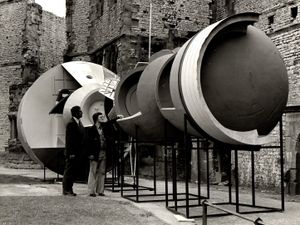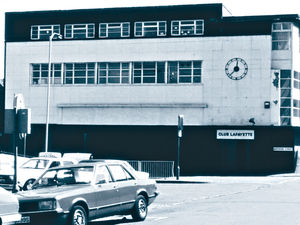Galaxy Quests: The latest goings-on at NASA from Artemis I to DART
Fly me to the moon, let me play among the stars... ah Frank, you are and have always been, my true spirit animal.

Back in 1964, with his recording of this Bart Howard classic, Mr Sinatra was of course far from the only one who wanted to see what spring was like on Jupiter and Mars. Thanks to US President John F. Kennedy’s national goal for the 60s of “landing a man on the Moon and returning him safely to the Earth”, the eyes of the world were fixed firmly on American space agency NASA.
Five years later, this historic dream would finally be achieved, when astronauts Neil Armstrong and Buzz Aldrin set foot on the lunar surface for the first time.
One small step for man... and you know the rest...
Others followed in their wake, yet not since December 1972 has man set foot on the Moon. Now, almost 50 years later, we’re getting ready to go back.
It will not have escaped those following its progress that NASA’s new lunar-faring programme, Artemis, has got off to a bit of a rocky start, with its first mission’s launch having been delayed several times, most recently in the last week due to storm fears.
But here, we’re keeping the faith.
With the space agency still firmly committed to returning man to the Moon, Messrs Bezos and Branson determined to deliver Joe Bloggs an interstellar outing he’ll never forget, and a certain Mr Musk looking to colonise the Red Planet, we think it’s time to be getting seriously excited about the final frontier.
And let’s not forget that from the ashes of its latest Artemis I setback, NASA made spectacular strides last week in deflecting killer asteroids from Earth! Quite a crowning achievement, and one that any fans of 1998 disaster flick Armageddon will be powerless not to grin at the glory of.
Yes folks, the moment for a little galactic giddiness is now, so here we’re digging into the latest goings-on at NASA.
Strap yourselves in, ladies and gentlemen. It’s time to boldly go...
Artemis I launch beset with problems
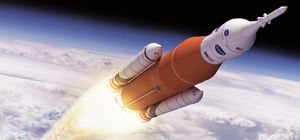
Due to fears over the arrival of Hurricane Ian, NASA once again postponed the highly-anticipated launch of its new moon rocket.
Alas, this marks the latest in a number of unfortunate launch delays for Artemis I – the unmanned lunar-orbiting test flight that will be the inaugural mission in NASA’s first programme to follow-up the Apollo landings of half a century ago.
Hydrogen fuel leaks and other technical issues caused the previous cancellations.
Playing it safe as the storms looked set to build, NASA rolled its moon rocket from a launch pad back to its Kennedy Space Centre hangar on Tuesday, September 27 (the latest due date for lift off), adding weeks of further delay to a test flight.
The Space Launch System rocket is the most powerful ever built by NASA. Assuming its first test flight goes well, astronauts would climb aboard for the next mission in 2024, leading to a two-person moon landing in 2025.
The space agency has reportedly promised that this third Artemis mission will witness the first time in history that a woman will set foot on the lunar surface.
While frustrating setbacks have plagued Artemis I’s launch – originally scheduled for August 29 – folks at NASA are keeping their spirits up, and remain excited about a return to the moon after five decades away.
With this first mission in the Artemis programme, NASA is hoping to lead the next steps of human exploration into deep space, where astronauts will build and begin testing the systems near the Moon needed for lunar surface missions and exploration to other destinations further from Earth, including Mars.
“This is a mission that truly will do what hasn’t been done and learn what isn’t known,” said Mike Sarafin, Artemis I mission manager at NASA Headquarters in Washington. “It will blaze a trail that people will follow on the next flight, pushing the edges of the envelope to prepare for that mission.”
It may be a little late to lift off, but Artemis I is still set to kick off a programme that will make history, and here’s all you need to know before it does:
- Artemis I, formerly Exploration Mission-1, will be the first integrated test of NASA’s deep space exploration systems: the Orion spacecraft, Space Launch System (SLS) rocket and the ground systems at Kennedy Space Center in Cape Canaveral, Florida.
- The first in a series of increasingly complex missions, Artemis I will be an uncrewed flight test that will provide a foundation for human deep space exploration, and, according to NASA, “demonstrate our commitment and capability to extend human existence to the Moon and beyond”.
- During this flight, the spacecraft will launch on the most powerful rocket in the world and fly further than any spacecraft built for humans has ever flown.
- It will travel 280,000 miles from Earth, thousands of miles beyond the Moon over the course of about a four to six-week mission.
- Orion will stay in space longer than any ship for astronauts has done without docking at a space station, and return home faster and hotter than ever before.
- The outbound trip to the Moon will take several days, during which time engineers will evaluate the spacecraft’s systems and, as needed, correct its trajectory.
- Orion will fly about 62 miles (100 km) above the surface of the Moon, and then use the Moon’s gravitational force to propel Orion into a new deep retrograde, or opposite, orbit about 40,000 miles (70,000 km) from the Moon.
- The spacecraft will stay in that orbit for approximately six days to collect data and allow mission controllers to assess the performance of the spacecraft.
- For its return trip to Earth, Orion will do another close flyby that takes the spacecraft within about 60 miles of the Moon’s surface. The spacecraft will use another precisely timed engine firing of the European-provided service module in conjunction with the Moon’s gravity to accelerate back toward Earth.
- This manoeuvre will set the spacecraft on its trajectory back toward Earth to enter our planet’s atmosphere travelling at 25,000 mph (11 kilometres per second), producing temperatures of approximately 5,000 degrees Fahrenheit (2,760 degrees Celsius).
Armageddon averted for now
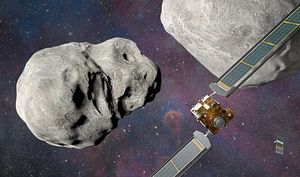
Though Artemis I is yet to launch, NASA has been celebrating after having successfully crashed a spacecraft into a small asteroid last week as part of a planetary protection test mission.
Sounds like a strange reason to set the party poppers off – but don’t worry, the crash was all part of the plan.
While asteroid Dimorphos posed no threat to Earth, the aim of the mission was to demonstrate that dangerous incoming rocks can be deflected by smashing into them.
“IMPACT SUCCESS!” NASA tweeted after its spacecraft, known as Double Asteroid Redirection Test (DART), collided with the 170-metre wide (560ft) asteroid about 00.20 UK time on Tuesday, September 27.
The US space agency’s staff cheered and clapped in a video shared online as the vending machine-sized spacecraft successfully smashed into Dimorphos, which is the size of a football stadium.
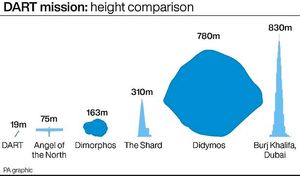
“And we have impact. A triumph for humanity in the name of planetary defence,” a member of NASA’s team said in a video recorded in the control room as the collision took place.
In a live question-and-answer session after the crash, senior leaders from NASA and Johns Hopkins Applied Physics Laboratory said the mission was “straight down the middle” and nothing went wrong.
Dimorphos is part of a binary asteroid system and orbits Didymos, which takes around 11 hours and 55 minutes. But astronomers at NASA hope that DART, while destroying itself in the process, has shortened this orbital period by about 10 minutes.
It will take several weeks before scientists can say whether the experiment has worked.
NASA previously said: “DART’s target asteroid is not a threat to Earth but is the perfect testing ground to see if this method of asteroid deflection – known as the kinetic impactor technique – would be a viable way to protect our planet if an asteroid on a collision course with Earth were discovered.”
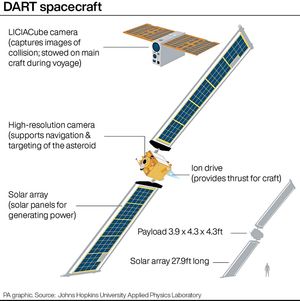
There are currently somewhere around 27,000 asteroids in near-Earth orbit.
Rocks that are 140 metres (460ft) and larger in size and come nearer than 4.7 million miles (7.5 million km) during orbit are classed as potentially hazardous asteroids (PHAs).
The DART mission was the first ever full-scale demonstration of asteroid deflection technology. The spacecraft recently captured its first images of Didymos and Dimorphos using an onboard instrument, known as the Didymos Reconnaissance and Asteroid Camera for Optical navigation (Draco).
It was about 20 million miles (32 million km) away from the asteroid system when it took the photos in July. It took 10 months for DART to come close to Dimorphos after launching last November on SpaceX’s Falcon 9 rocket.
The asteroids were around 6.8 million miles (11 million km) from Earth when the collision happened. DART accelerated at about 13,700 miles per hour (22,000 kilometres per hour) before colliding with Dimorphos.
The collision was recorded by a briefcase-sized satellite known as the Light Italian CubeSat for Imaging of Asteroids (LICIACube), which was provided by the Italian Space Agency.
LICIACube, which weighs just 14 kg (31 lbs), hitched a ride with DART into deep space before recently separating from the spacecraft in a final farewell.
In 2024, the European Space Agency (ESA) will launch its Hera spacecraft, which will go on a two-year journey to the asteroid system to gather information in the aftermath of the crash.
ESA said: “By the time Hera reaches Didymos, in 2026, Dimorphos will have achieved historic significance: the first object in the Solar System to have its orbit shifted by human effort in a measurable way.”


